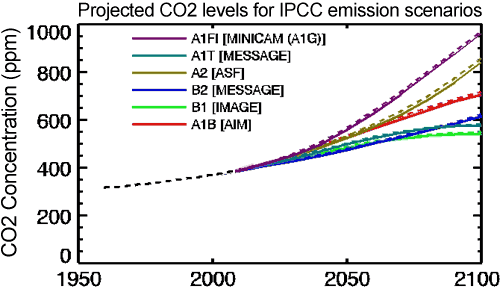Is the CRU the 'principal source' of climate change projections?
Posted on 16 May 2011 by Robin2
In the wake of the illegal hacking of emails from the University of East Anglia, climate skeptics criticised the global temperature records jointly held by the Climate Research Unit (CRU) at UEA with the UK Met Office – arguing that the evidence that temperatures are rising is therefore unreliable.
As has been profiled both on Skeptical Science and at Carbon Brief, there are three principal surface temperature datasets, of which the CRU/Met Office hold just one. Temperature datasets are just one (important) part of our scientific understanding of climate change.
Despite this, some climate skeptics claim that scientists at the CRU or Met Office are responsible for the majority of projections about what climate change will look like in the future.
This is typified by this quote from the founder of the UK climate sceptic think-tank the GWPF, Lord Nigel Lawson:
“Moreover, the scientific basis for global warming projections is now under scrutiny as never before. The principal source of these projections is produced by a small group of scientists at the Climatic Research Unit (CRU), affiliated to the University of East Anglia.”
Skeptics like to suggest that climate projections depends entirely on the institution that they’re currently attacking. It’s a technique to allow them to smear the whole of climate science with the failings – real or imagined – of just one group.
For examples, see Christopher Booker’s attack on CRU in the Sunday Telegraph, or skeptic blogger Richard North’s attack on the Met Office in the Daily Mail, where he writes:
“The Met Office seems to have forgotten what it was set up for - to predict weather day by day. Instead, it is devoting its energies to the fantasy that it can predict climate decades ahead when it cannot even tell you whether it is going to snow next week, or whether we might have a barbecue summer.”
In reality, of course, climate projections are not just produced by the Climatic Research Unit or the Met Office. The IPCC fourth assessment report, published in 2007, used climate projections produced by 16 modelling groups, from 11 countries, using 23 models. Even more researchers are involved in the IPCC 5th Assessment Report (due to be published in 2014), with 20 modelling groups from all around the world working on it so far.
The AR4 climate projections were based on greenhouse gas emissions scenarios that depict how the future might unfold, depending on how emissions and their causes change in the future. The scenarios consider changes in population, economics and the development of new technologies. The different scenarios are outlined in the Special Report on Emission Scenarios, developed by the IPCC (see graph below).

Atmospheric CO2 concentrations as observed at Mauna Loa from 1958 to 2008 (black dashed line) and projected under the 6 IPCC emission scenarios (solid coloured lines). (IPCC Data Distribution Centre)
All of the climate model output used in AR4 is available online, resulting (at the time of writing) in 575 peer-reviewed publications, both using and critiquing the data.
So how much does our understanding of climate change depend on the CRU? They provide climate models and a number of datasets to the climate science community, including records of changes in surface temperature since 1850. These show good agreement with other temperature records such NASA's Goddard Institute of Space Studies (GISS) and NOAA's National Climatic Data Centre (NCDC).
Using a combination of models from many different research groups allows the IPCC scientists to more successfully reproduce features of earth's current climate than by using only a single model.
Comparing the ability of models to reproduce past and current climate change with observational data also allows the uncertainties in climate projections to be assessed.
In summary, it is the combined work of scientists from many different parts of the world which produces projections for the future impacts of climate change. These projections are complicated and time-consuming to produce, as they are dependent on so many unknown factors - how societies and economies will develop, where we will get our energy from, the unknowns in how the earth and atmosphere will respond to rising greenhouse gases, and the limitations of computer models (something we will discuss in a future post). Many scientists around the world - rather from just one or two institutions - are working together to try and reduce these uncertainties and increase our understanding of the future impacts of climate change.































 Arguments
Arguments






























[DB] Tamino shows clearly the nature of the "Cherry-pick" that is 2003:
Looking at the totality of the data:
Smoothed (5-year averages), one gets this:
[DB] Apologies for not being more clear. Being tired (and no doubt lazy) at that moment, I wrote the descriptive verbiage from memory. The 5-year graphic is from this post by Tamino. He clarifies the graphics here:
[DB] Please, no all-caps. And you really ought to learn more about models.
[DB] If you have the temerity and feel the need to tell a world-class professional time-series analyst that you know better than he...well, I'm hardly of a mind to talk you out of what will be an interesting learning experience for all. You have the proper thread over at Open Mind to post your correction on, so I expect to read said corrective effort there forthwith.
In the meantime I'm placing my confidence in that same professional who has already proven his knowledge and understanding of climate science beyond that posted by the majority here (and yes, that includes myself).
[DB] Inflammatory snipped. Please keep it clean. And no all-caps.
[DB] Please, no more all-caps.
[DB] Please see Stephen Baines' response to you on the Oceans Are Cooling thread. Keep your responses there, which is a much more appropriate thread than here. Thanks!
[DB] Fixed link.